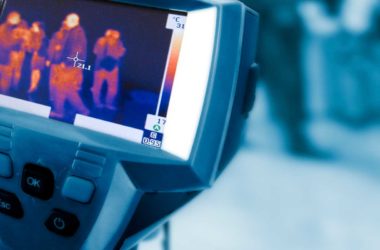Sport is no stranger to technological innovation. Over the years technology and sports science have been working in tandem to improve the output of professional and amateur athletes. But as well as transcending the limits of human capability, how else have AI and robotics changed the game?
You’re out of breath and drenched in sweat.
You’ve hit a wall with your training.
“NOT GOOD ENOUGH!” your coach shouts at you.
You give your coach a glare. You look ahead at your training course. You know it’s right.
You read correctly. It.
In the not-too-distant future, human coaches will be replaced by AI-powered robots designed to crunch the data being emitted by your wearables. Your robo-coach will be able to give you a personalised and accurate training programme. With a data-led fitness plan, you can focus your training on where you need it the most, and know what areas to avoid to prevent injury. At least that’s the hope of many researchers working in the sport tech field.
We’re not quite there yet, but progress in related areas does look promising. For instance, robots are already helping sporting production teams source relevant historic reels. They’re helping anti-doping boards catch cheats.
They’re even participating in sporting events themselves.
Robots getting in on the game
As technology advances, we can expect the possibilities surrounding sport tech to advance too. These are some of the most exciting developments so far.
Footballing robots
RoboCup is an international research initiative that has been running since 1997. According to its website, the aim of the competition is to “promote robotics and AI research”, using one of the world’s most popular sports.
But it’s not all robot football matches. RoboCup has expanded to include rescue robots, home application robots and unmanned aerial vehicle operation. Even referees are robotic.
Researchers are optimistic about the competition.
“The ultimate goal of RoboCup is to develop humanoid soccer-playing robots that can beat the FIFA world champion team,” Gerhard Kraetzschmar, the General Chair of RoboCup 2016, told Digital Trends. “We hope to reach that goal by 2050.”
Present-day RoboCup robots suggest there’s still a long road ahead. Without humanlike physical agility, perception or stamina, the results are often comical. Modern robots tend to be heavy, with battery packs needing to be replaced during the match. They also rely on artificial limbs that lack the flexibility to fluidly kick the football. On top of that, coding isn’t quite sophisticated enough for robots to autonomously assess factors such as field positioning and strategy.
Fortunately 2050 is still quite a while away.
Skiing robots
The Winter Olympics aren’t just for talented athletes. It turns out, robots can participate too. In early 2018 at Welli Hilli ski resort, a course located an hour away from the main action in Pyeongchang, robots took part in what is believed to be the first robot skiing competition in the world.
The event was organised by the South Korean government to promote its robotic advancements. It saw eight teams competing for a $10,000 prize. There were some basic rules: robots had to be in humanoid form (i.e. stand on two legs and have joints resembling elbows and knees), measure at least 50cm tall, and use regular poles and skis.
Embedded camera sensors were used to help each humanoid navigate the slopes and avoid the flagpoles that lined the course. The results, though relatively impressive, suggest skiing is not going to be taken over by robots any time soon.
Basketball robots
CUE is a basketball-playing robot built as a side project by a team of Toyota engineers. At 190cm tall, the robot is shorter than the average NBA player. However, CUE can shoot free throws with 100% accuracy – a figure that tops the current NBA average of 77%.
The robot itself is rather basic. It can’t pick up balls by itself nor move around on its own. However, it can squat, aim and throw. According to Japanese news organisation Asahi Shimbun, CUE practised shooting 200,000 times and used AI to hone its skills.
Racing robots
A lot has been said about autonomous cars being safer than human drivers on the road. But are they faster?
Enter: Roborace, a race series for autonomous cars.
The latest prototype for the race is DevBot, an entirely electric car weighing in at 975kg and with four motors of 300kW each. It’s capable of doing speeds of over 200mph and uses a range of technologies to drive itself. These include two optical sensors, five lidars, six AI cameras, two radars, 18 ultrasonic sensors and an Nvidia’s Drive PX2 brain (which can compute 24 trillion AI operations per second).
Consensus: Mechanical gladiators? Not quite. Today’s robotic athletes show promise, but it’s clear they’re not taking over human sports any time soon.
Technology augmenting sports
Coaches set goals based on what they can see. It’s often the only way athletes know how they’re doing so they can work on their mistakes and focus their training.
However, with technology, coaches have a whole host of previously undetectable metrics to help them make better judgements.
With the ability to measure movement, heart rate, body temperature and more, wearables are proving to be a total game changer for many athletes.
Football fitness kits
The 2015/16 season was the first time UK Premier League teams were allowed to use wearable devices during matches. The devices make use of sensors (such as accelerometers, gyroscopes and compasses) and GPS technology to collect data and help coaches to better understand their players’ performance.
Output can be compared with objectives and training history. And while the data can’t predict if a player will get an injury or not, it can reduce the chances of it happening.
It’s hoped these devices, used alongside data on opponents, can eventually help teams fine-tune their strategies and decide which players to bring on in matches.

Batting for success
England cricket players have also got in on the wearables action. In 2017, Jason Roy, Ben Stokes and Alex Hales became the first England cricket players to use microchips on their bats.
The microchip, called Batsense, has been designed by Intel. It measures the speed of stroke, angle of backlift and time between lifting the bat and hitting the ball.
The data not only gives players more insight into their technique, but also acts as a valuable broadcasting tool.
“As broadcasters, how often have we spoken about ‘fast hands’ or ‘great bat speed’ – but what do we actually mean? We’ve never quantified it,” says former England captain Nasser Hussein.
“All in all, as a broadcasting tool, it will give context for the viewer.”
It’s worth noting readings from wearables will be affected by a range of external factors. This includes how the device is worn, how the equipment is held, or what kind of serve, shot or kick the player performs. Such variables will need to be considered when matching up player data and events. Added to that is the need to share. Coaches, physiotherapists, dieticians and doctors will need to communicate and collaborate with IT to make the most of the data.
When robots and humans meet
Prosthetic limbs have come a long way in recent years. No longer are they awkward, uncomfortable or limited in functionality. Instead, today’s prosthetic limbs can be custom fitted and even customised for various sports. And thanks to advances in batteries, microprocessors and AI, these limbs can do everything from lifting to grabbing and feeling.
Yet their acceptance into the sporting world beyond the Paralympics hasn’t been easy.
Oscar Pistorius made history in 2012 when he became the first double-leg amputee to compete at the Olympic Games. Previously in 2008 he was considered ineligible for the event by the International Association of Athletics Federations (IAAF) after researchers found his prosthetic limbs gave him an advantage over other athletes not using them. However, this decision was reversed after a follow-up study found Pistorius’s artificial limbs, though mechanically different from intact limbs, were physiologically similar.
Yet questions surrounding whether or not mechanical differences can enhance running speeds still remain. The debate around Pistorius’s performance was to eventually become overshadowed by the court case that saw him convicted of murdering his girlfriend.

A more recent example involves Markus Rehm, a German paralympic long jump champion, who is yet to convince officials he should be allowed to compete at the Olympic Games. Rehm is a single amputee, who launches off on his right, prosthetic leg. He’s already recorded distances that would’ve won him gold at the last three Olympic Games. However, according to former IAAF Council Member Helmut Digel, the type of prosthetic blades that Rehm uses gives him an illegal competitive advantage.
lt is in nobody’s interest if we come to a situation where able-bodied athletes and disabled
Helmut Digel (via IAAF)
athletes using technical aids are considered equal in competition. If this happens, inclusion will have trumped fair competition, and the point of sport will be lost
The use of prosthetics in sports begs the question: what is natural talent? After all, certain types of shoes can potentially offer different performance outputs. And an athlete making the most of wearables will have a more nuanced training regime. It’s an ethical question that’s yet to be fully answered.
The future playing field
From training and performance to spectating, AI and robotics have the huge potential to transform sports in a whole host of ways.
The examples above merely represent the tip of the sporting iceberg. Other potential applications of AI include chatbots being used to interact with fans, automated video highlights for better live broadcasting, and AI being used to optimise advertising placement. Even the process of buying a ticket and attending an event can be improved by AI technology.
But for now athletes will still have to play. How they train, compete and improve will no doubt be influenced by the advances in robotics to come. As spectators, we can only sit back on our couches and watch (with our equally improved broadcasting).











